The
"Exceptions" Group
In this page are illustrated, by
means of line drawings1, the two Fleetwood bodies
with styling codes beginning "44...". These are, in my opinion, two
mystery styles that escape Fleetwood's otherwise logical categorizations.
The two sixteens in this group
["pair" would seem a more appropriate term] have some typical body styling
characteristics which I have highlighted in the artist's rendering, below.
These same characteristics are found on sixteens belonging to other sub-categories or
groups, yet these two cars were disallowed from the latter groups. Why?
Well, although they feature a
combination of horizontal belt molding and straight (horizontal) sill, typical of
sixteens in the "41..." or "Madame X" group, these two cars were
excluded simply because 2-door cars and town cars were not allowed in that group. In
addition, although they feature the straight (horizontal) sill that is typical of sixteens
in the "43..." group, they were excluded also from that group owing to the
absence of the raised, curved hood panel.
This raises another question. Why
were styles #4302 and #4381 included in the latter group ["43..."] despite their
lacking also the distinguishing raised, curved hood panel? Perhaps Fleetwood became
more stringent in their style numbering policies in 1931. Indeed, the twelve cars in
the "44..." group all were built in 1931 whereas the majority of the #4302
roadsters (87 out of a total of 105) and the smart #4381 coupes (91 out of a total
of 98) were built in 1930. This may be simply the beginning of an explanation. On
the other hand, it does not help us to understand the coding of unique Fleetwood styles
(or jobs?) #2950LX and #3289B, both of which were built also in 1931.
Who can offer some clarification ?
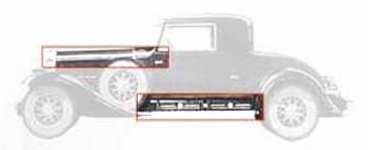
Styling characteristics of the two
sixteen-cylinder cars
with a job or style code beginning with "44...": straight,
lower body sill and horizontal belt molding. These cars
might have readily fit in the "41" group had the first
not been a 2-door model and the second a town car
Style 4476
[11 units]: As a 2-passenger coupe it would have been more logical to
include this model in the "42" group, but the Fleetwood designers gave it a
horizontal sill, so the "41" or "43" groups would have been
appropriate. It would have fit in the "43" group if the designers had not
given it the flat, raked "Madame X" windshield; the latter is incompatible
with the curved, raised hood panel of the "43" group. The hood and sill design
would have fit the "41" group ...except that the latter accepted only 4-door
cars. So what was left? That’s right, a new group, that I shall call the
"exceptions group" although only two sixteens are included. This racy
coupe cost $5800. See article in SIA106 p.64 [sorry, wrong issue; I need to research this again], including
details of tail-light, fender side-light, tool and battery compartments, p.28.
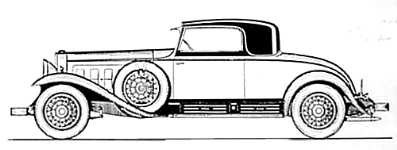
Designer's drawing of the racy Fleetwood style 4476
coupe with "Madame X" windshield.
(note the golf-bag door is not shown in that drawing although the car was built
with it)
Style 4412
[unique]: Although the build sheet exists
for this car, no photographs, designer's drawings or artist's renderings have been
uncovered. The line drawing below is my own impression of what this car might have looked
like, founded on a study of all Fleetwood body styles, both on the V16 chassis, and others
of the same period. The car is described in the Master Parts List as having a flat
windshield (presumably the same one as used for town cars in the "42..." group).
That would mean it would have had a horizontal belt molding and a plain hood, i.e. without
the curved, raised panel (the latter was matched only with the flat windshields and the
raked "V" windshields of the town cars in the "43..." group).
How about the sill? Would a car like this have had the coach sill? Well, if it had,
there is no doubt that Fleetwood would have placed it in the "42..." group. So
we have to assume it had a horizontal sill. As to the interior layout, I suspect it was
very much like the other town cars with styling codes ending with the digits
"...12".
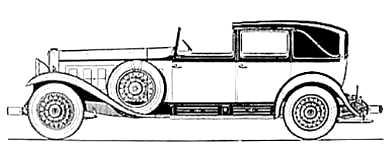
Above: my own impression of what style #4412
may have looked like.
Below, for the sake of comparison, are (left) style #4212 and (right) style #4312
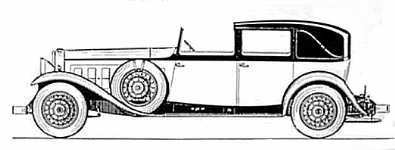 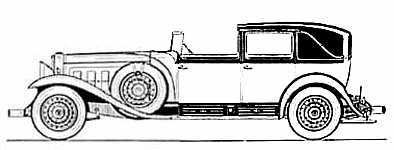
_________________________________
1 Included
in the product catalog for the Vee-sixteen models is an envelope of designer's drawings of
the most common body styles offered; drawings are not available for all styles so, where
there was none, I have used an existing drawing and made appropriate changes to illustrate
the missing style; sometimes I have had to use my imagination so please do not
consider these "montages" as "factory original" drawings.
|
![]()